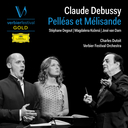...Naturally gifted with an astonishing tonal range, Kozená's emotionally nuanced delivery is nothing short of mesmerising. The programme's pairing of Joseph Haydn's Arianna A Naxos, based on the Greek myth of Ariadne and Theseus, with Wolfgang Amadeus Mozart's Vitellia from La Clemenza Di Tito - both of them tragic heroines - is an inspired platform for Kozená to vocalise a pain, anguish and desolation which is heart-rending in scope and utterly convincing in its truthfulness.
Arianna, abandoned by Theseus, and Vitellia - who faces exposure as the instigator of the plot to murder the emperor Titus and a separation from her lover Sesto - are on the verge of despair and both Haydn and Mozart's scores potently chart their emotional upheaval.
Kozená believes that in songs language has the same value as music and that "neither the words, nor the sounds the words make, have a greater importance. It's a whole package. Such clarity would have been music to the ears of Haydn who, following a performance of Arianna in 1790, complained that the singer was not articulating clearly.
Conductor Bernard Labadie made Les Violons Du Roy from Quebec soar and blend with Kozená's intoxicating rendering of her characters' extreme moods. It's a "wall of sound" that gave everyone goose pimples, including the orchestra, who repeatedly applauded Kozena. A match made in heaven.
The programme gave Kozená respite by allowing Labadie and Les Violons to indulge the audience with arresting "instrumentals" of Mozart's Symphony No 33 and Haydn's Symphony No 85.
Needless to say, encores were demanded and in repsonse 'Voi, che sapete' from The Marriage Of Figaro was delivered with memorable gusto.
© Krystyna Zavisha



